Horsefly bites are rather unpleasant, and almost everyone who spends time outdoors in the summer has experienced them at least once. The thought alone of being attacked by these flies is enough to have you worried, and they are known to be very persistent.
Horse flies, which are actually a species of fly in the family Tabanidae, are a pest for almost any mammal.
The female horse fly, just like the female mosquito, is responsible for the bite. Males rely primarily on pollen and nectar for feeding.
If you have livestock, such as horses or cattle, that the presence of these pests has impacted, read on. You’ll learn everything you need to know about horse flies and how to get rid of them.
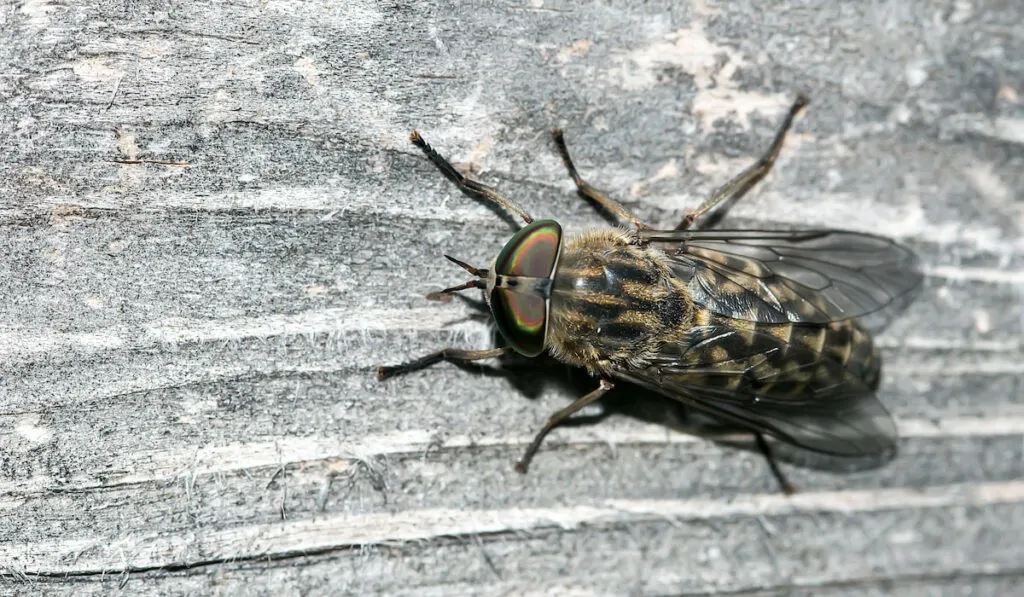
Table of Contents
Facts About Horse Flies
1. The Tabanidae Family
The Tabanidae family of flies has over 4,000 species spread nearly globally, including both horse flies and deer flies. Tabanids are also often called clegs or gadflies, which are less common names for them.
2. What Do Horse Flies Look Like?
Horse flies are one of the largest flies in the world, making them easy to recognize.
The bodies of horse flies are large and stocky, measuring 3/4 to 1-1/4 inches in length.
The color of their exoskeleton can range from a dark brown to a grayish black to an almost-black hue.
These insects are also easily distinguished by their large eyes, which can be either emerald or black.
3. Horse Flies vs. Deer Flies
The horsefly and the deer fly are both true members of the Tabanidae family. Their size and wings are telltale signs of the species.
Horse flies range in size from 3/4 to 1-1/4 inches in length, and they have transparent or solid wings and vividly colored eyes.
Deer flies are smaller, when compared to horse flies but have dark bands across their wings and colorful eyes.
4. Horse flies vs. House flies
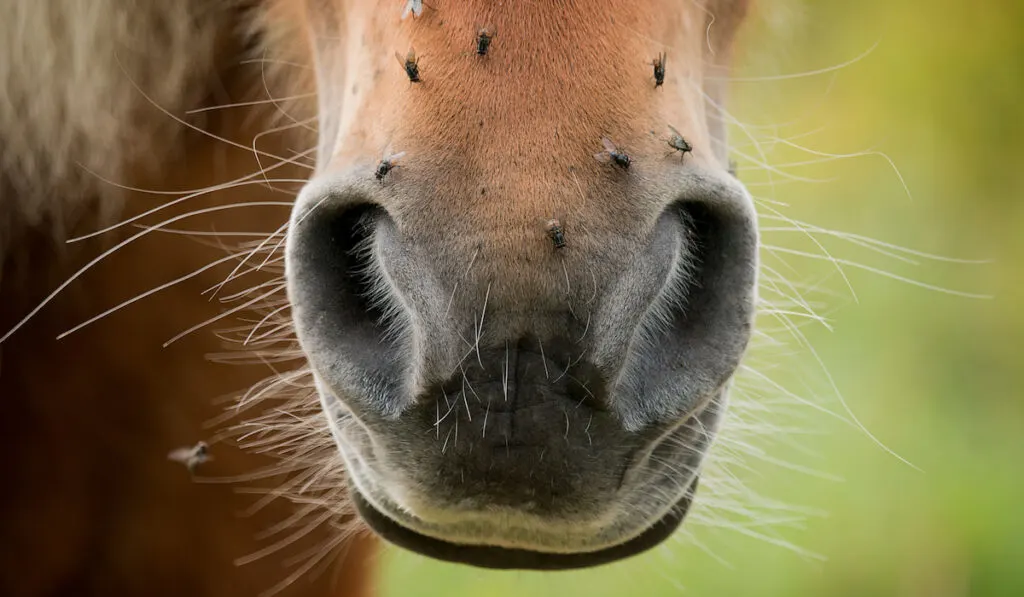
When comparing houseflies and horse flies, size is the most telling characteristic.
The average length of a house fly is around a quarter of an inch, making it significantly shorter than its larger relative, the horsefly.
Horse flies, on the other hand, can grow to be around an inch long, making them roughly twice as large as any regular houseflies.
5. Length of the Horse Fly Life Cycle
There are four phases in a fly’s life cycle: egg, larva, pupa, and adult. This entire process can take more than a year.
Generally, mature horse flies have a short lifespan of only 30 to 60 days.
6. Growing Up
There are a wide range of possible egg counts that females can produce, from 25 to 1,000. The eggs are typically placed on a vertical surface, such as plants, rocks, branches, or watery vegetation.
The locations on which the eggs are laid are always directly above water and on damp ground, both of which are beneficial to the growth of the larvae.
After hatching from these eggs in about a week, the larvae fall to the ground, where they feed on decomposing organic matter or the minute organisms that live in the water or soil.
The larval stage typically lasts one year, although this might vary depending on the characteristics of the surrounding environment.
Mature larvae will crawl to drier locations in order to pupate, and eventually, they will emerge as adults.
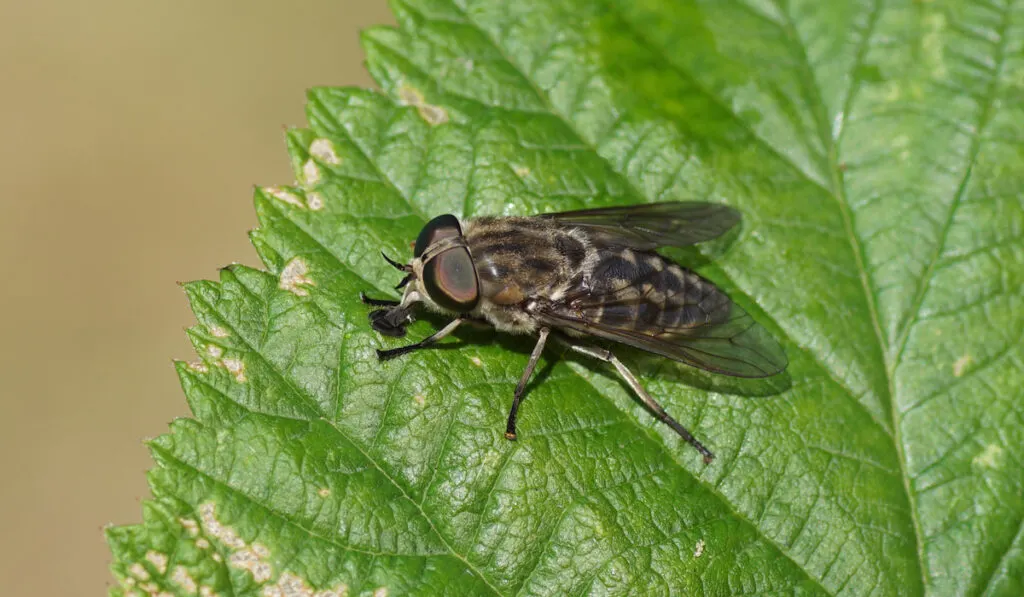
7. Who Is Biting?
The mouth parts of the female horse flies are well-developed. Hence, it is the female horse fly that bites.
Male flies have very poorly developed mouthparts and are consequently incapable of biting.
8. Why Are They Biting?
The life cycle of the horse fly depends on the blood of the mammal that the females bite.
Females can bite repeatedly because the proteins they obtain from blood feeding help them produce more eggs and allow the eggs to mature properly following fertilization.
9. Are Horse Flies Really Biting?
Some flies bite, but the horsefly doesn’t. They use their sharp mandibles to cut through skin and blood vessels.
The mouthparts of flies are built of soft, spongy structures known as labella.
The female fly uses these labella to drink up the blood that leaks from her victim’s wound.
10. Horse Flies Stings
Compared to other insect bites, a horse fly sting can be quite painful, and the healing process may be prolonged. Hence, you can tell horse fly bites by the pain and welts they leave behind.
In some cases, the bites may get infected. If puss or other signs of sickness show up, you should talk to the doctor.
Characteristics of a horse fly bite include the following:
- A horse fly sting will hurt because, unlike some other insects, it does not release an anesthetic when it bites.
- The fly’s mouth parts are like the teeth on a saw, and instead of making a small hole, they cut.
- Bite victims typically experience localized swelling and welting.
Some of the other things that can happen after being bitten by a horse fly are:
- Rash
- Puss
- Other parts of the body also get swollen
- Dizziness
- Weakness
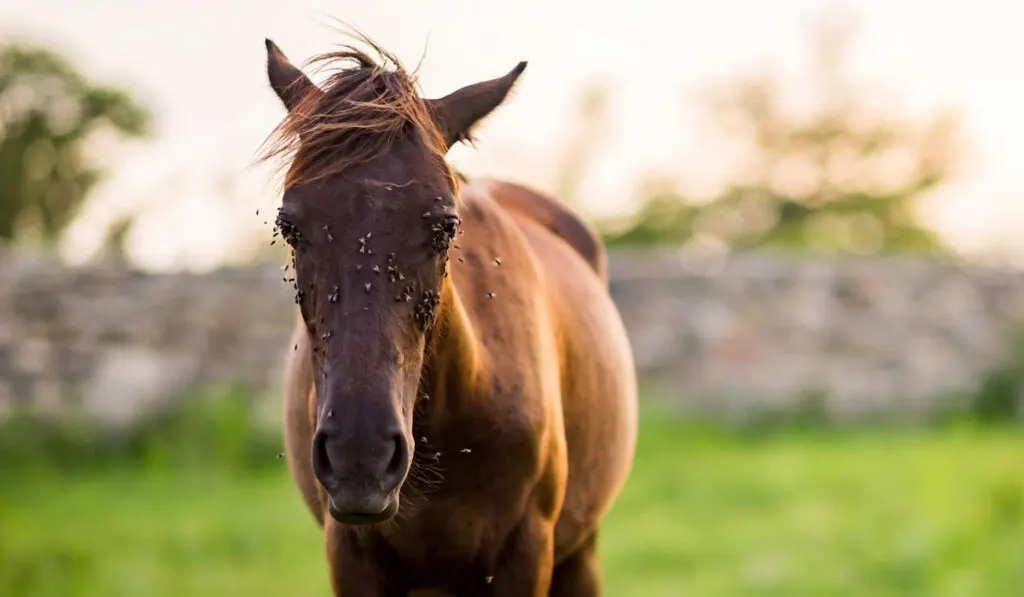
11. Flying Speed
Horse flies may appear to be large, but they are fast fliers. They have incredible speed surges.
For example, a male of a North American fly species was seen flying at 90 mph while chasing a female.
12. What Attracts Horse Flies
Horse flies like moist environments and warmer temperatures, and it’s common to find them in meadows near rivers, ponds, or lakes in the summer.
Near our homes, yards, and farms, they seek out areas with weeds and long grass that might hold moisture and provide the humid conditions they prefer.
13. The Horse Flies Hosts
Almost any mammal, including humans, livestock, pets, and even birds, can become a host for a horsefly.
But female horse flies, particularly, seek out the legs and bodies of large, sedentary animals like horses and cows for a meal.
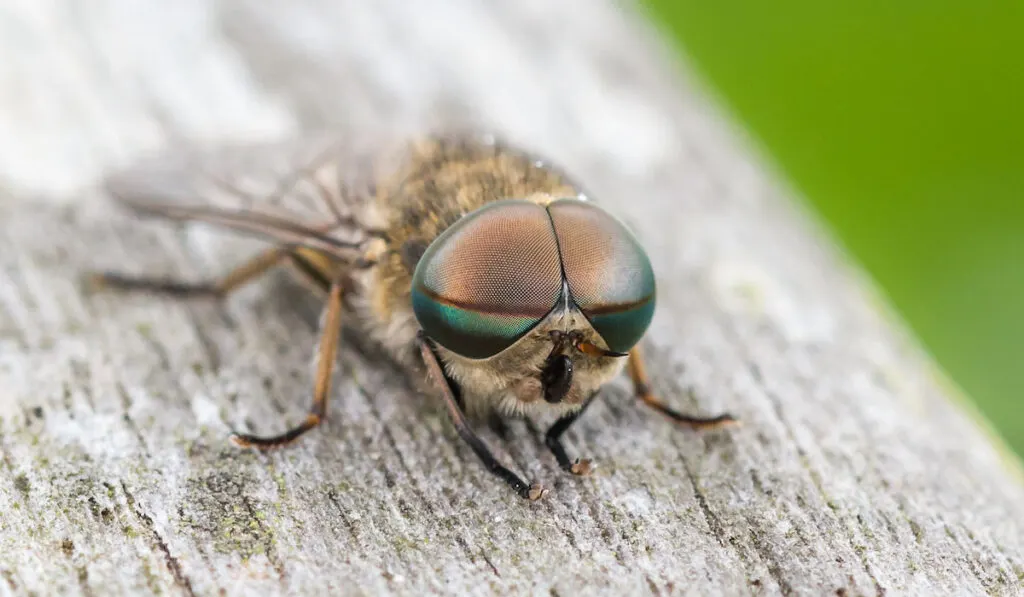
14. Are Horse Flies Aggressive?
Horse flies are dangerous to both humans and animals. To restate the answer, horse flies are indeed aggressive.
The female horse fly is aggressive, and its bite is very painful since the insect’s mouthparts rip rather than pierce the skin.
15. Are Horse Flies Carriers of Disease?
Aside from the temporary discomfort, horse fly bites are not normally hazardous to people.
Horses are typically the only ones who suffer from these bites. This is because horse flies transmit equine infectious anemia, often called swamp fever.
16. What Eats a Horse Fly?
Horse flies are eaten by birds, which eat both adults and larvae.
Wasps and nematodes are two other parasites that feed on the larvae.
Solitary wasps use adult flies as a food source for their egg caches, and spiders do prey on them as well.
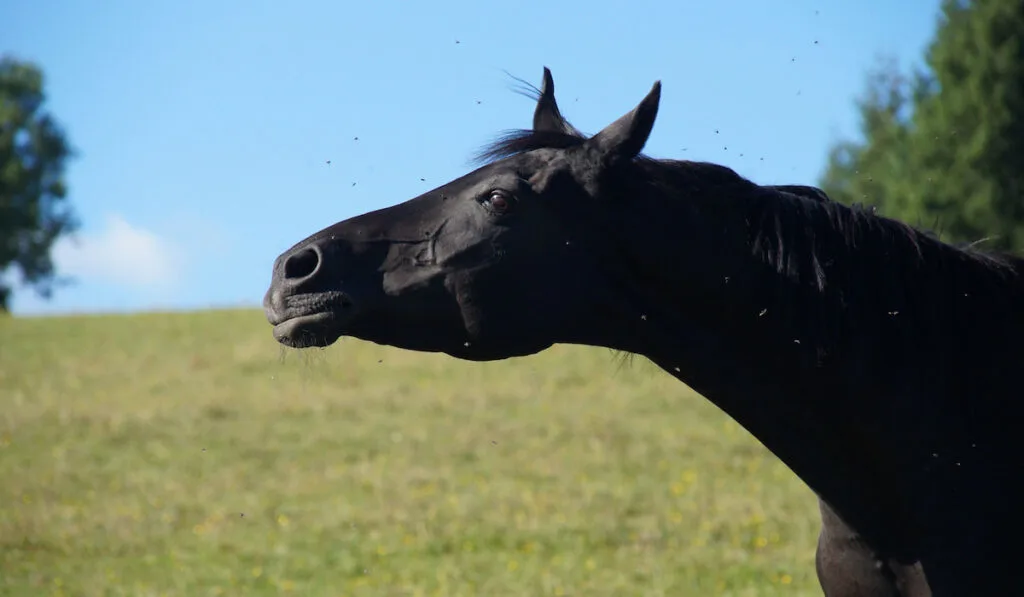
How to Get Rid of Horse Flies
1. Destroying Breeding Grounds
Destroying breeding grounds, hives, and nests is typically the most effective way to deal with most kinds of unwanted pests.
However, using this method against horse flies can be problematic because their breeding habitats are often not close to human households.
Additionally, they might also reproduce in protected regions, which would prohibit any efforts to eradicate the species.
For you, the only method to successfully fight these hostile insects is to eliminate and prevent them as soon as possible after finding their presence on your property.
2. Bug Zappers Fly Trap
Bug zappers work by putting out UV light that bugs are attracted to. Once the bugs are in the middle of the device, they are usually struck by lightning between two metal grids.
A bug zapper is more useful and effective when left on continuously. An alternative is to use an insect zapper from nightfall until morning.
3. Flies-Be-Gone Fly Trap
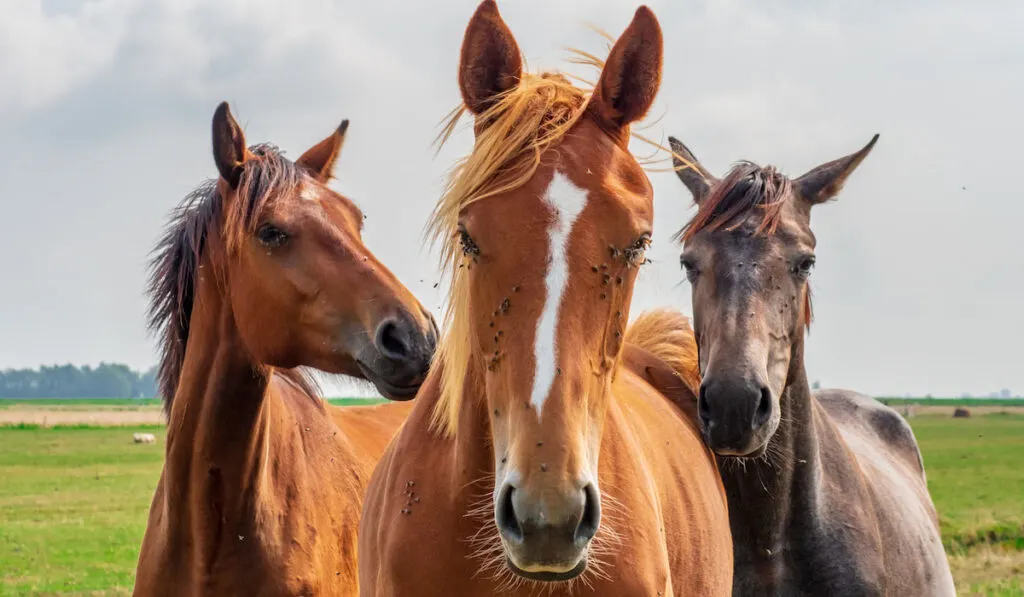
When you add water to the Flies-Be-Gone Fly Trap bag, the component inside dissolves and starts working.
Flies are attracted to the trap by the smell and drown in the water after getting in through the yellow top cover.
You can hang them from the ceiling, place them on flat surfaces, or position them near a light for maximum effect.
4. Horse Pal Fly Trap
When it comes to outdoor horsefly control, Horse Pal is one of your best bets.
The female horse fly is drawn to the trap by the heat coming from a black, inflatable ball that hangs inside.
As the flies land on the black ball, they are lured to the catch bin of the trap, where they will become trapped and unable to escape.
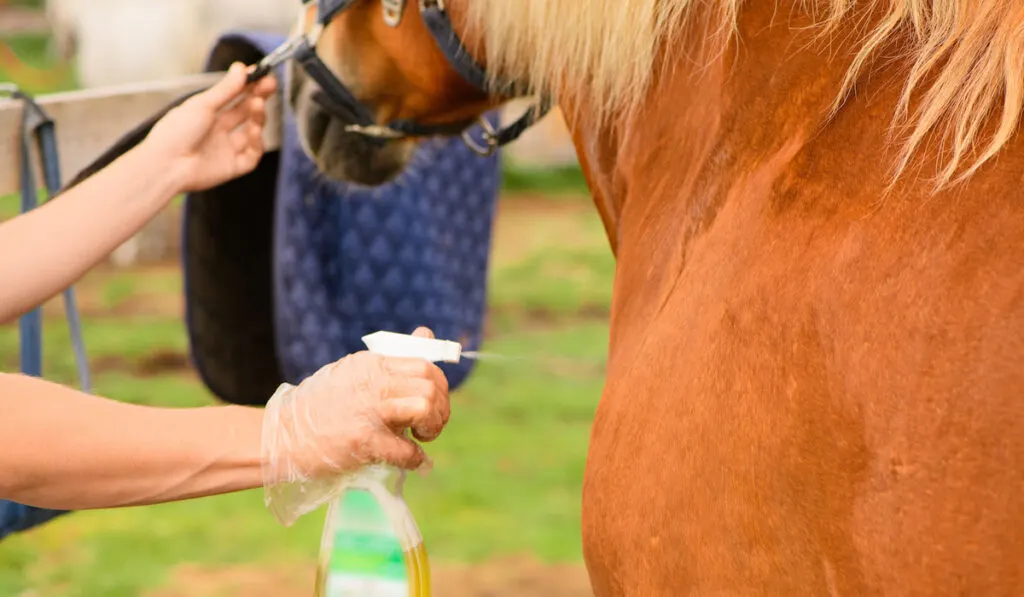
5. Essential Oils Are a Weapon Against Flies
Essential oils are plant-based substances used to prevent pests.
Typically, they are safe for use on your skin as well as on horses when applied in measured amounts.
The following are examples of some of the best oils for fly repellent:
- Lemon
- Citronella
- Orange
- Bergamot
- Geranium
- Lemongrass
- Eucalyptus
- Lavender
- Peppermint
- Sage
- Cedarwood
- Rosemary
Fly spray can be easily made at home by combining a few drops of oil with water. Try a range of oils to find the one that works best for you and your horse.
6. Give Your Horse a Bath to Get Rid of Horse Flies
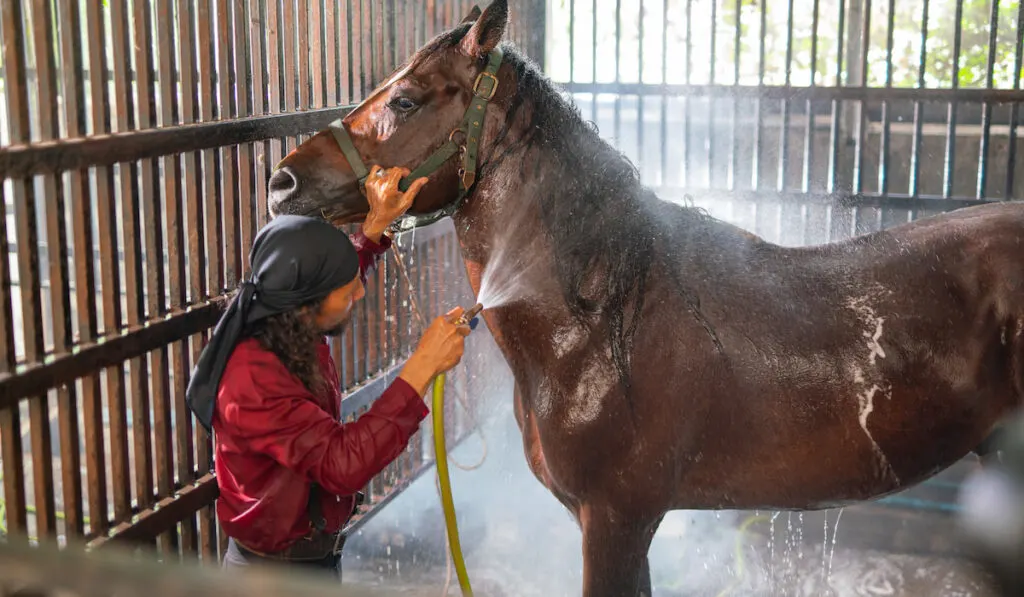
Because horse flies seek out horses and cattle, taking precautions to safeguard your animals is essential. A pyrethrin bath is usually the best option.
Many ranchers use pyrethrin, a non-toxic natural insecticide, to protect their horses or cows from horse flies.
You will keep horse flies at bay by giving your horses a bath in this solution once a day or once every other day.
7. Your Horses’ Manure Is the Horse Fly’s Favorite Spot
Controlling fly populations begins with maintaining a clean environment and properly handling waste.
Your horses’ manure is not only a breeding ground for flies but also an ideal habitat for them. Therefore, eliminating them straight from manure is the most effective strategy.
The first step is to clean the stables regularly, but you must also consider where the manure goes afterward.
Spreading the manure is the most effective method since it destroys the fly breeding ground and dries it out.
It will help if you spread manure thinly so that it dries up quickly and doesn’t attract more flies than necessary.
8. Stable, Barn, and Yard Protection
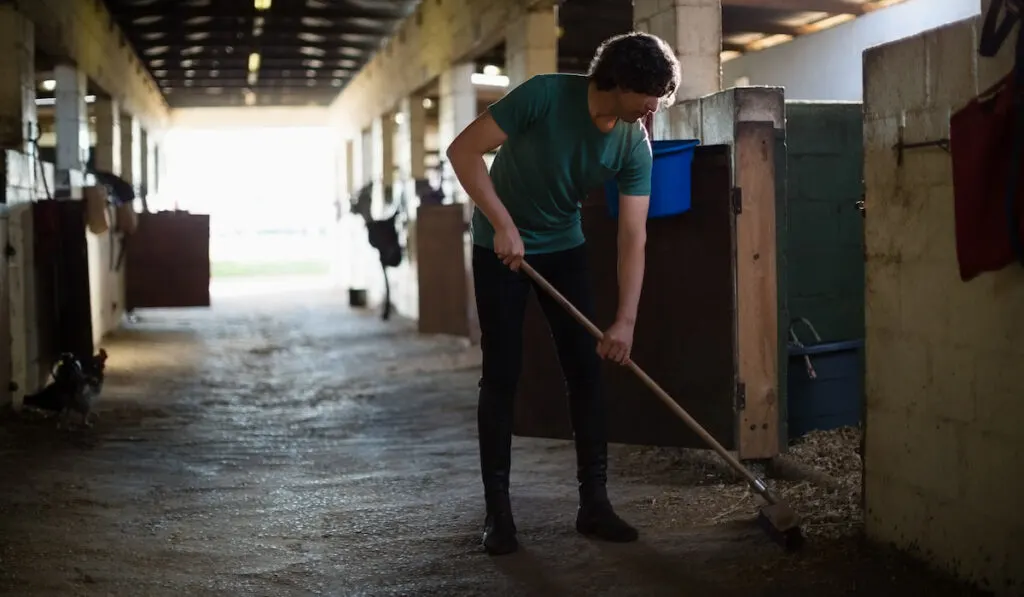
In order to reduce the number of flies in an area, it is necessary to first eliminate any potential breeding grounds.
The following are some suggestions for keeping a stable, barn, or yard free of horse flies:
- Cutting the grass shorter to prevent flies from resting there.
- Getting rid of the moisture and puddles that tend to form around water troughs or tanks.
- Cleaning out feed buckets often so that flies don’t get attracted to the leftovers.
- Using fans in the stable to move the air around, making it harder for flies to find their way to your horses.
9. Protect Yourself
Horse fly protection options include store-bought bug sprays and highly effective homemade essential oil repellents.
Wearing light colors will also help because horse flies use the difference between dark and light to find their victims.
Even so, when going outside in horse fly season, it is best to cover as much skin as possible.
Final Thoughts
In the summer, it is hard to avoid being bitten by a horse fly, and their bites tend to hurt more than those of other insects.
Big, dark animals like horses are a favorite food of horse flies. But that doesn’t stop them from biting people whenever they get the chance.
The female horse fly needs blood for nourishment in order to lay eggs and defend the life cycle.
But remember that there are ways to protect yourself and your animals from them.
Our article is always here for you with a handful of helpful tips about horse flies and how to deal with them.
Resources
- https://entomology.ca.uky.edu/ef511
- https://entnemdept.ufl.edu/creatures/livestock/deer_fly.htm
- https://extension.umaine.edu/home-and-garden-ipm/fact-sheets/common-name-listing/horse-flies/
- https://www.vpm.org/2021-08-02/the-biting-truth-about-horse-flies
- https://extension.entm.purdue.edu/publichealth/insects/tabanid.html
- https://www.solutionsstores.com/pyranha-pyrethrin-shampoo-for-dogs-and-horses
- https://www.kbis.co.uk/advice/homemade-fly-spray/
- https://natran.com/how-to-get-rid-of-horse-flies/
- RESCUE! Outdoor Disposable Fly Trap, Green
- Aspectek 20W Electric Indoor Bug Zapper, Mosquito
- Flies Be Gone Fly Trap - Disposable Non Toxic Fly Catcher
- https://horse-fly-trap.com/
- https://ortho.com/en-us/garden/how-to-keep-horse-flies-away-from-your-yard.html
- https://www.pestworld.org/pest-guide/flies/horse-flies/
- https://www.medicalnewstoday.com/articles/313714#severe-reactions

